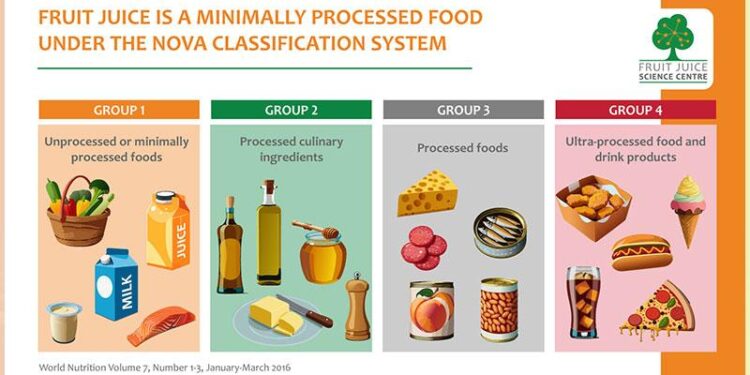As consumers become increasingly mindful of their dietary choices, the terms “minimally-processed” and “ultra-processed” foods are entering everyday conversations – but what do they really mean? In this article, USA Today breaks down the key differences between these categories, exploring how each impacts nutrition, health, and the way Americans eat. From fresh produce to packaged snacks, understanding these distinctions can help guide smarter food decisions in an age where convenience often clashes with wellness.
Understanding the Nutritional Impact of Minimally Processed and Ultra Processed Foods
When analyzing the nutritional profiles of minimally processed and ultra-processed foods, the distinctions become clear beyond just their production methods. Minimally processed foods typically retain most of their natural nutrients, fibers, and beneficial compounds because they undergo limited alterations such as washing, cutting, or freezing. These foods often contain:
- Whole grains, fresh fruits, and vegetables
- Unprocessed meats and seafood
- Natural dairy products without additives
In contrast, ultra-processed foods are the result of multiple industrial processes and often include additives like preservatives, colorings, and flavor enhancers. This extensive processing usually diminishes the nutritional quality, leading to:
- Higher levels of added sugars, unhealthy fats, and salt
- Lower fiber and micronutrient content
- Increased calorie density with minimal satiation value
| Aspect | Minimally Processed Foods | Ultra-Processed Foods |
|---|---|---|
| Processing Level | Light alterations preserving natural state | Multiple stages with chemical additives |
| Nutrient Density | High, rich in vitamins and fiber | Low, often depleted of nutrients |
| Health Impact | Supports balanced diet and longevity | Linked to obesity, heart disease, and diabetes |
| Typical Examples | Fresh fruits, plain yogurt, roasted nuts | Soda, sugary cereals, snack cakes |
How Ultra Processed Foods Affect Your Health Compared to Their Less Processed Counterparts
Ultra processed foods typically contain high levels of added sugars, unhealthy fats, and artificial additives that contribute to chronic inflammation, obesity, and associated health problems such as type 2 diabetes and cardiovascular disease. Unlike their less processed counterparts, these foods often lack essential nutrients, fiber, and natural antioxidants, making them not only calorie-dense but nutritionally poor. Studies have shown that diets rich in ultra processed items increase the risk of metabolic syndrome and promote unhealthy eating patterns through their addictive taste and convenience.
In contrast, minimally processed foods retain most of their natural nutrients and provide benefits that support long-term health. These include:
- Higher fiber content that aids digestion and maintains stable blood sugar levels.
- Better vitamin and mineral availability to fuel the body’s natural processes and immune function.
- Lower glycemic index which helps prevent spikes in blood sugar.
| Health Aspect | Ultra Processed Foods | Minimally Processed Foods |
|---|---|---|
| Added Sugars | High | Minimal to None |
| Nutrient Density | Low | High |
| Inflammation Risk | Elevated | Reduced |
| Satiety | Low | High |
Expert Tips for Making Healthier Food Choices in a Convenience Driven Market
Prioritize whole ingredients: In a market flooded with quick fixes and ready-to-eat options, always scan the ingredient list. Ingredients that you recognize-such as fresh vegetables, nuts, grains, and lean proteins-are clear indicators of minimally-processed foods. In contrast, frequent additives like high-fructose corn syrup, artificial colors, and flavor enhancers often signal ultra-processed products. Experts recommend choosing items with five or fewer ingredients to maintain nutritional integrity and avoid excess sugars, unhealthy fats, and sodium.
Incorporate these practical strategies to navigate convenience shopping:
- Shop perimeter aisles: Fresh produce, dairy, and meats usually line these areas, reducing temptation from packaged goods.
- Batch prep meal components: Cooking grains or roasting vegetables in advance turns minimally-processed foods into fast, ready servings.
- Read nutrition labels: Focus on fiber-rich, nutrient-dense options and be wary of marketing claims that may mask poor ingredients.
Making healthier choices doesn’t mean sacrificing convenience-it’s about smarter selection backed by knowledge.
| Food Type | Typical Ingredients | Nutrition Highlight |
|---|---|---|
| Minimally-Processed | Vegetables, nuts, whole grains | High fiber, vitamins, low additives |
| Ultra-Processed | Preservatives, flavorings, sweeteners | Often high in sugar, sodium, unhealthy fats |
To Conclude
In navigating the often complex landscape of food choices, understanding the distinctions between minimally-processed and ultra-processed foods is crucial for making informed decisions about health and nutrition. While minimally-processed foods retain much of their natural nutrients and offer clear benefits, ultra-processed items often contain additives and ingredients linked to negative health outcomes. As consumers become increasingly aware of these differences, the push for clearer labeling and better education continues to grow. Staying informed and reading beyond the packaging can empower you to choose foods that support a healthier lifestyle.































